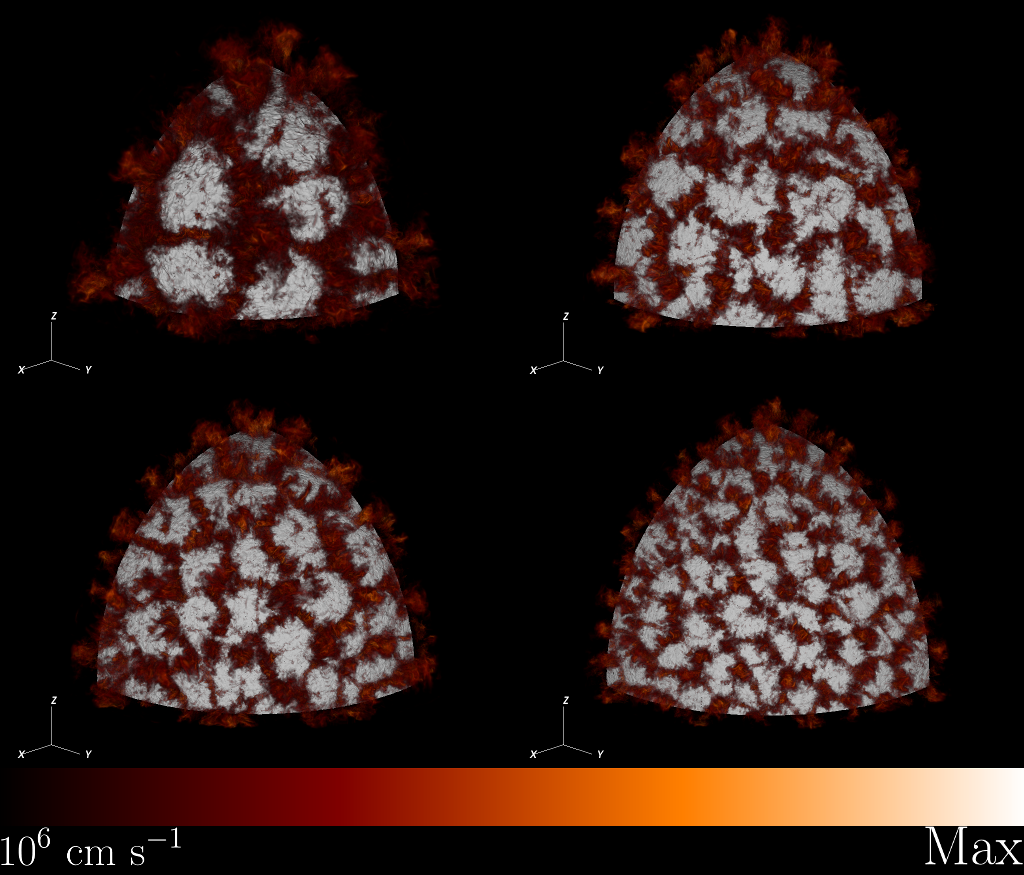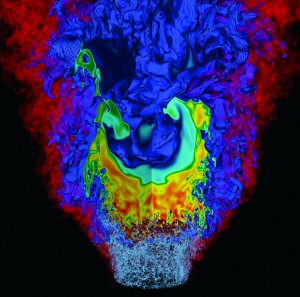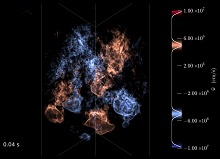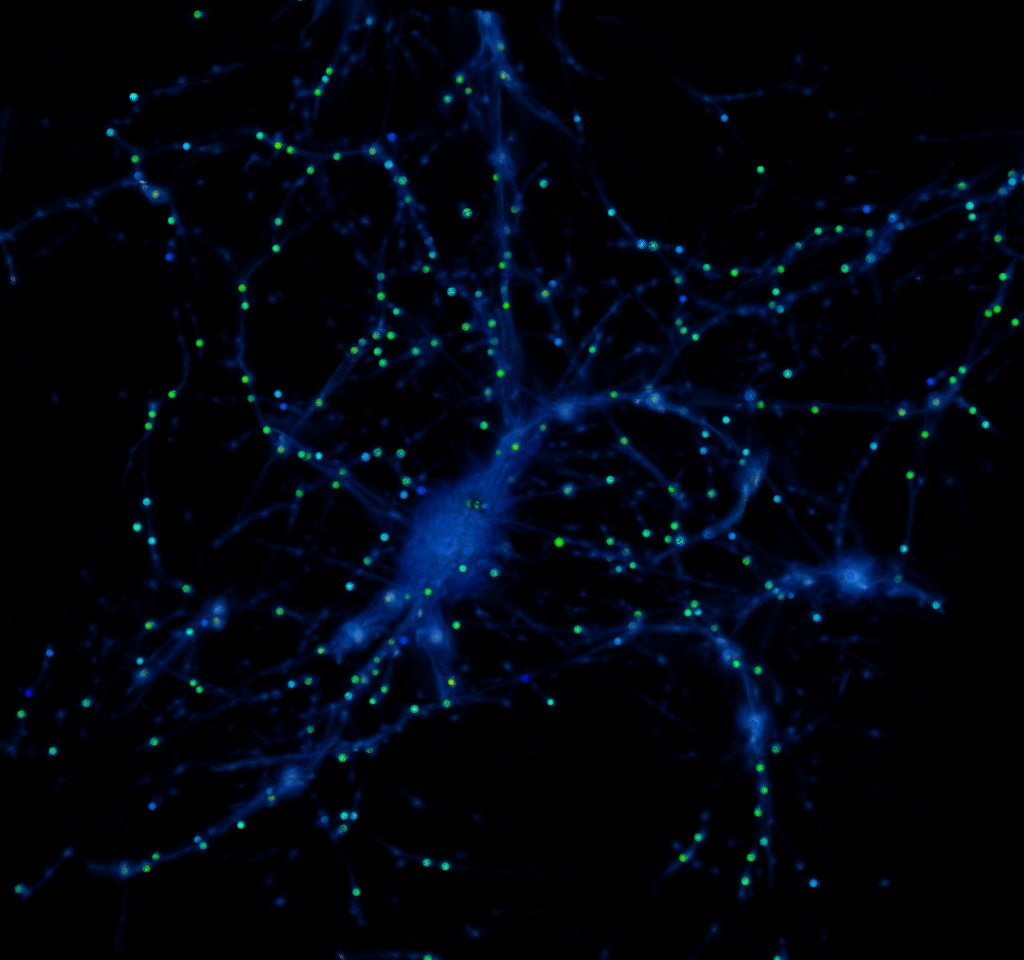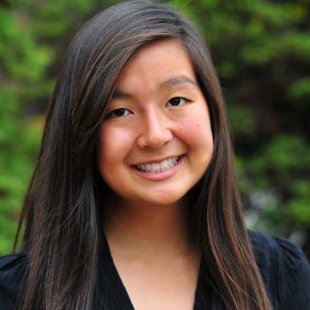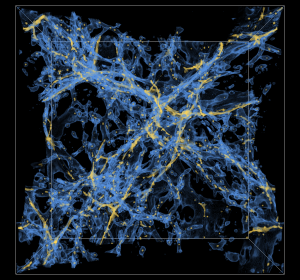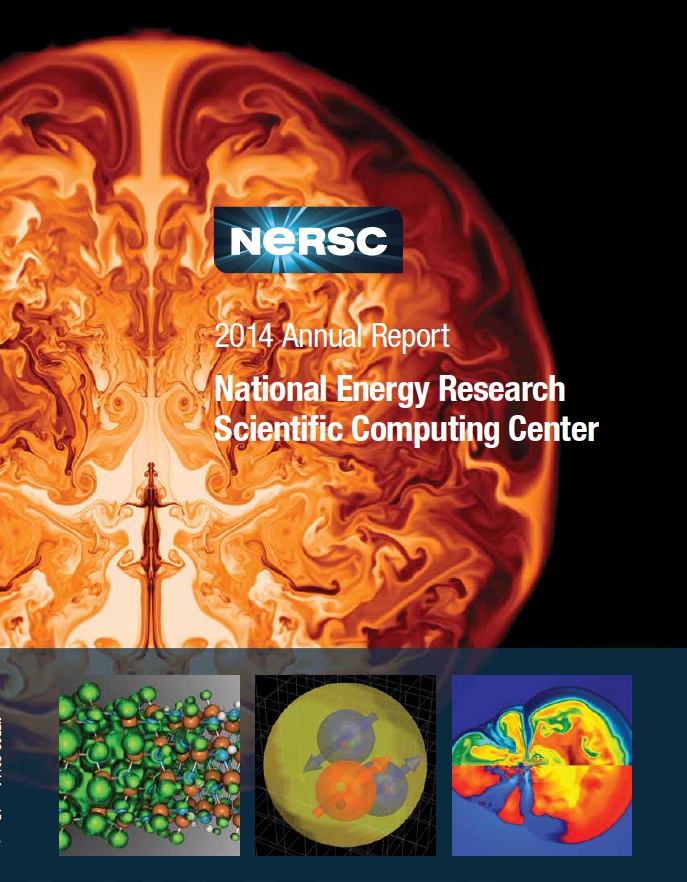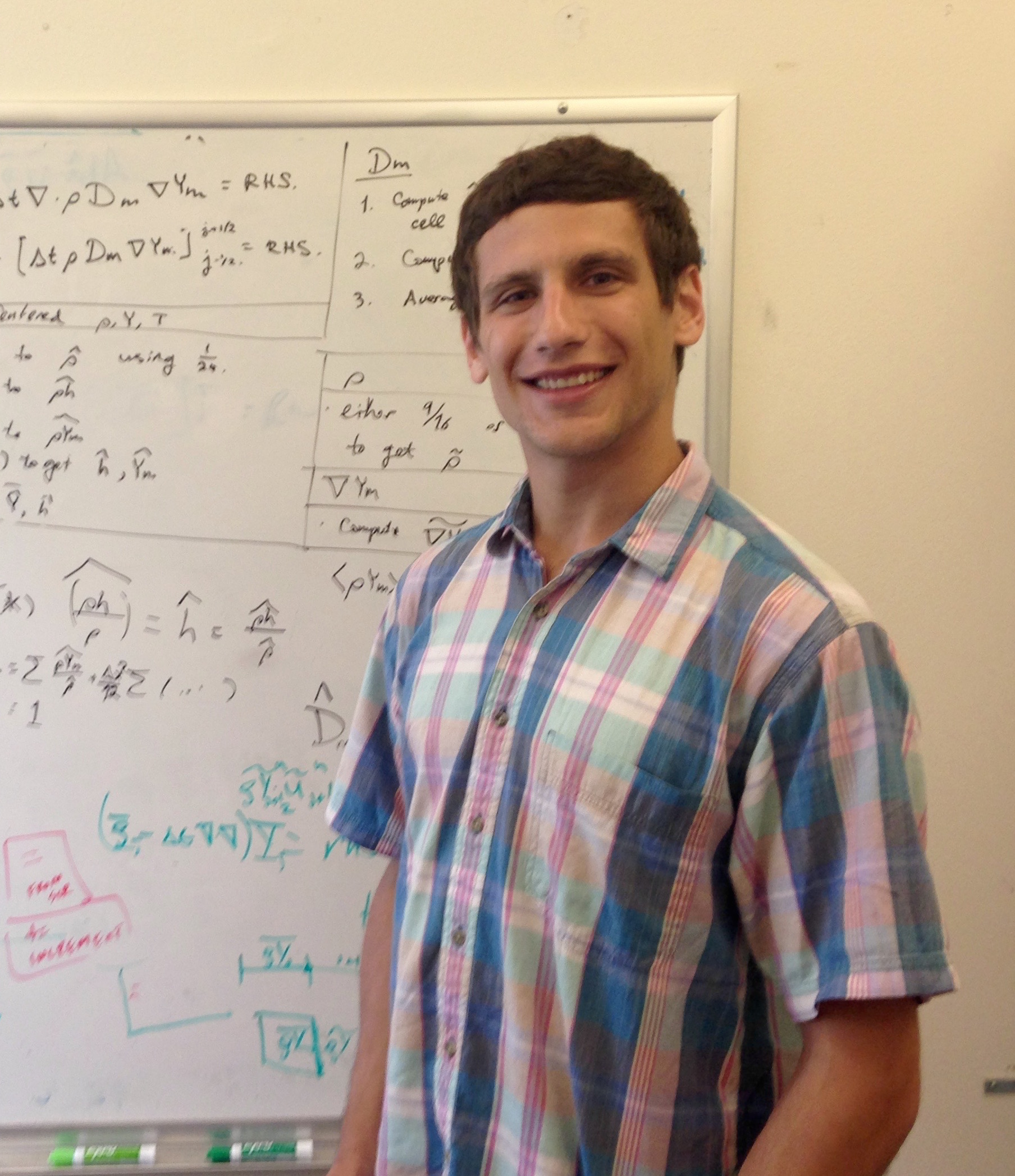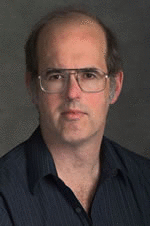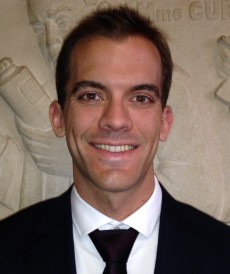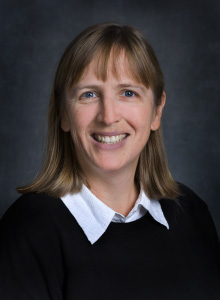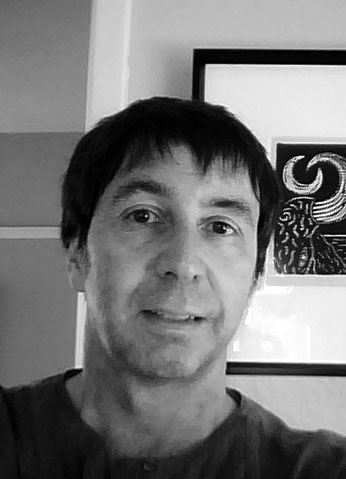
Home |
News |
Research |
Publications |
People |
BoxLib |
Links |
Downloads |
December 2015 News
Juliane Mueller Kicks Off 2015 Bay Area Scientific Computing Day Co-Organized by Marc DayJuliane Mueller was the first speaker at the 2015 Bay Area Scientific Computing Day, a one-day meeting focused on fostering interactions and collaborations between researchers in the fields of scientific computing and computational science and engineering from the San Francisco Bay Area and nearby regions. The event provides junior researchers a venue to present their work to the local community, and for the Bay Area scientific and computational science and engineering communities at large to interchange views on today's multidisciplinary computational challenges and state-of-the-art developments. This year, the event was held on Friday, December 11, 2015 at Lawrence Berkeley National Laboratory. Marc Day and Chao Yang of LBNL's Computational Research Division organized the meeting, which included a welcome from ALD Kathy Yelick and 9 half-hour talks by junior researchers. The poster session featured almost 20 posters, and there were over 80 registered participants. |
|
|
|
MAESTRO Simulations Used to Model SN Ia ProgenitorsA team led by Michael Zingale of Stony Brook University is exploring the physics of Type Ia supernovae using the MAESTRO code for modeling low Mach number astrophysical phenomena. The team's latest research focuses on a specific class of Type Ia supernovae known as double-detonation supernovae, a process by which a single star explodes twice. This year, the team completed a 3D, high-resolution investigation of the thermonuclear burning a double-detonation white dwarf undergoes before explosion. "In 3-D simulations we can see the region of convective burning drill down deeper and deeper into the star under the right conditions," said Adam Jacobs, a graduate student on Zingale's team. "Higher mass and more burning force the convection to be more violent." The MAESTRO simulations were carried out on the Titan supercomputer at Oak Ridge National Laboratory using CPU hours allocated in a recent INCITE award. See the recent ORNL article about their work here. |
2015 INCITE Awards -- CCSE and Collaborators Awarded 96 Million Hours for Combustion SimulationsIn a renewal of a 2-year INCITE award, members of CCSE and collaborators from Sandia National Laboratories, Stanford University, National Renewable Energy Laboratory, SINTEF (Norway) and Oak Ridge National Laboratory have been awarded 96 million hours on the Titan Cray XK7 at Oak Ridge National Laboratory as one of the 56 2015 US DOE's INCITE awards. The project, titled DNS of Turbulent Combustion Towards Fuel-Flexible Gas Turbines and IC Engines, is led by Jackie Chen of Sandia National Laboratories. The team will carry out a suite of first-principles petascale DNS of underlying turbulence-chemistry interactions in gas-phase combustion. These DNS benchmarks will enable the development of predictive models for lifted diesel flame stabilization, discerning flame and ignition propagation in reactivity controlled compression ignition combustion, and ensuring intrinsic flashback safety in fuel injection systems for fuel-flexible gas turbines. |
|
|
|
2015 INCITE Awards -- CCSE and Collaborators Awarded 55 Million Hours for Astrophysics SimulationsIn a renewal of a 2-year INCITE award, members of CCSE and collaborators from UC Berkeley, UC Santa Cruz, Stony Brook University, and Los Alamos National Laboratory have been awarded 55 million hours on the Titan Cray XK7 at Oak Ridge National Laboratory as one of the 56 2015 US DOE's INCITE awards. The project, titled, Approaching Exascale Models of Astrophysical Explosions, is led by Professor Michael Zingale in the Department of Physics and Astronomy at Stony Brook University. The team is carrying out a comprehensive study of two classes of thermonuclear-powered stellar explosions involving compact objects, Type Ia supernovae (SNe Ia) and X-ray bursts (XRBs). Key to their analysis is the use of two multiphysics simulation codes developed in CCSE -- MAESTRO and CASTRO --- which are specifically designed for the efficient modeling of astrophysical explosions. "The team's primary goal of the project will be to explore a variety of initial configurations of stellar explosions in the densest stellar objects in the Universe," said Zingale. |
November 2015 News
Mueller Honored as one of the 2015 "Women @ The Lab"Juliane Mueller has been named one of the 2015 "Women @ The Lab" and will be honored at a reception on November 18. As part of the honor, Juli will be featured on this year's Women @ The Lab poster, available here, and her profile is available here. |
|
|
'Sidecars' Lead the Way to Concurrent Analsyis of Large-Scale Simulations: BoxLib's New 'SideCar' Capability Featured in InTheLoop"A new software tool developed through a multi-disciplinary collaboration [of Vince Beckner, Brian Friesen, Ann Almgren, Gunther Weber, Dmitry Morozov and Zarija Lukic] allows researchers doing large-scale simulations at the National Energy Research Scientific Computing Center (NERSC) and other supercomputing facilities to do data analytics and visualizations of their simulations while the simulations are running. The new capability will give scientists working in cosmology, astrophysics, subsurface flow, combustion research and a variety of other fields a more efficient way to manage and analyze the increasingly large datasets generated by their simulations. It will also help improve their scientific workflows without burning precious additional computing hours." Read more here |
Mueller Wins Runaround in Her Age GroupThe official Berkeley Lab Runaround times were posted, and CCSE's own Juliane Mueller won her age group with a time of 12:32.5. Way to go Juli! |
|
October 2015 News
|
Former CCSE Summer Student Jessica Kawana Wins Award at Student Poster CompetitionJessica Kawana of Willamette University won third place at the CCSE-NW Student Poster Session for her presentation, "Parallelization Improvements to BoxLib Applications with Tiling and OpenMP". The poster describes the use of tiling constructs to improve thread performance for several BoxLib applications. Congratulations, Jessica! The poster can be downloaded here. |
BoxLib/Nyx Selected for NERSC Burst Buffer Early User ProgramNERSC has selected a number of HPC research projects to participate in the center's new Burst Buffer Early User Program, where participants will be able to test and run their codes using the new Burst Buffer feature on the center's newest supercomputer, Cori. The BoxLib/Nyx team composed of Ann Almgren, Vince Beckner, Brian Friesen, Gunther Weber and Zarija Lukic was one of the awardees, and will explore using the Burst Buffer for BoxLib-based I/O and for in transit analysis such as halo finding. From the official announcment: "Burst Buffers have the potential to transform science on supercomputers: removing I/O bottlenecks, enabling new workflows and bringing together data analysis and simulations," said Wahid Bhimji, a data architect at NERSC who is co-leading the Cori Early User Programs. "However, this is a brand new technology, offering a new way of working and bringing challenges from software to scheduling. So it is really important and exciting to be able to shape the use of this technology in collaboration with these important science projects." See the full announcement here. |
|
|
New Postdocs Changho Kim and Andreas Kreienbuehl Join CCSEChangho Kim and Andreas Kreienbuehl have just joined CCSE as postdoctoral researchers. Changho will be working with John Bell and Alejandro Garcia on the fluctuating hydrodynamics project. Andreas will be working with Michael Minion on parallel in time methods. |
September 2015 News
CCSE Research in Fluctuating Hydrodynamics Featured by physics.orgAn article first released on the Berkeley Lab News Center has now been picked up by physics.org. John Bell, Anuj Chaudhri, and Andy Nonaka are featured in the recent article, "Mathematicians Model Fluids at the Mesoscasle", which highlights new developments in fluctuating hydrodynamics modeling and simulation. The little-known field of fluctuating hydrodynamics could have enormous impacts in applications ranging from batteries to drug delivery to microfluidic devices. |
 |
| These images show spinodal decomposition (liquid and vapor components separating out spontaneously) in a near-critical Argon system from a homogeneous initial condition into droplets suspended in a majority vapor phase. |
CCSE Affiliate Alejandro Garcia Gives Keynote Lecture at DSMC 2015Alejandro Garcia recently attended and gave the Graeme A. Bird Keynote Lecture at the 2015 DSMC 2015 Conference held September 13-17 in Kauai, Hawaii. The talk was titled "How I Managed to Break DSMC." |
|
|
New Postdoc Jean-Philippe Peraud Joins CCSEJean-Philippe Peraud has just joined CCSE as a postdoc working with John Bell and Alejandro Garcia on the fluctuating hydrodynamics project. Jean-Philippe received his PhD in 2015 from the Department of Mechanical Engineering and Computation at MIT, where he focused mainly on stochastic numerical methods in transport and diffusion processes in nanoscale heat transfer. |
August 2015 News
CCSE Codes Featured on Front and Back Covers of
|
|
|
CCSE Summer Student Jessica Kawana Presents Poster at CSSSP Poster SessionJessica Kawana presented a poster titled "Parallelization Improvements to BoxLib Applications with Tiling and OpenMP" at the Computing Sciences Summer Student Program Poster Session held in the LBNL cafeteria on Thursday, August 6. The poster describes the use of tiling constructs to improve thread performance for several BoxLib applications. The poster can be downloaded here. |
CCSE Summer Student Will Pazner Presents Poster at CSSSP Poster SessionWill Pazner presented a poster titled "A High-Order Method for Low Mach Number Combustion" at the Computing Sciences Summer Student Program Poster Session held in the LBNL cafeteria on Thursday, August 6. The poster describes mathematical analysis by Will Pazner to identify an instability present in earlier approaches. The poster can be downloaded here. |
|
|
Bell Gives Invited Talk at ASCR Workshop on Turbulent Flow Simluations at the ExascaleCCSE's John Bell recently gave an invited talk on AMR for the Exascale at the ASCR Workshop on Turbulent Flow Simulations at the Exascale: Opportunities and Challenges, held August 4-5 in Washington DC. The workshop brought together experts in turbulent-flow simulation, computational mathematics and high-performance computing, and participants were "expected to help define a research agenda and path forward that enables scientists and engineers to continually leverage, engage and direct advances in computational systems on the path to exascale computing." |
July 2015 News
Mueller Presents at International Symposium on Mathematical ProgrammingJuliane Mueller recently presented her work on optimization algorithm development at the triennially held International Symposium on Mathematical Programming in Pittsburgh, PA. In her talk, GOSAC: Global Optimization with Surrogate Approximation of Constraints, Mueller introduced a computationally efficient method for solving optimization problems that have computationally expensive black-box constraint functions and computationally cheap objective functions. Problems with these characteristics are frequently encountered, for example, in engineering applications where costly computer simulations have to be run to compute the constraint function values. |
|
CCSE Summer Students Present At CRD Brown Bag SessionsJessica Kawana, a senior at Willamette University, and Will Pazner, a graduate student at Brown University, recently presented short talks on their summer projects at the Summer Student Brown Bag Sessions. Pazner's talk was titled "The spectral deferred correction method for multi-process problems" and described his work with CCSE's John Bell on algorithm development for reacting flow solvers using SDC. Kawana's talk was titled "Optimizing Fluctuating Hydrodynamics Code to run in Parallel" and described her work with CCSE's Andy Nonaka on inserting tiling in combination with Open MP directives into CCSE's FluctHydro code, a multicomponent flow solver written in BoxLib, and comparing that method to fine-grained loop-level OpenMP. |
|
CCSE's NESAP PostDoc Featured in ArticleBrian Friesen, the NESAP Postdoc working with CCSE, is the first of 8 postdocs to join NERSC's Exascale Science Applications Program, aka NESAP. Brian is working with CCSE's Weiqun Zhang to optimize or redesign existing algorithms in BoxLib to take advantage of the massive concurrency of Cori, NERSC's next-generation supercomputer that features a new manycore architecture. BoxLib is a massively parallel software framework for building codes with adaptive mesh refinement and is the basis for a number of scientific codes used in active research today. Click here to see the full article about Brian. |
Almgren Presents FASTMath Poster at SciDAC-3 PI MeetingAnn Almgren recently presented a poster titled "Logical Tiling in an AMR Framework: Implementation and Performance" at the 2015 SciDAC-3 Principal Investigator Meeting held in Bethesda, Maryland, July 22-24, 2015. The poster describes work by CCSE's Weiqun Zhang to implement logical tiling in BoxLib, and similar work by Anshu Dubey and Daniel Graves of ANAG. The poster can be downloaded here. |
|
June 2015 News
|
Alej Garcia Quoted on BuzzFeed about
|
Alvarez Fellow Juliane Mueller Gives Two Talks on Optimization in CanadaJuliane Mueller is presenting two talks in Canada this week on optimizing simulations. Mueller's area of expertise is developing algorithms to optimize "black box" simulations, so named because no description of the objective function is available. This optimization, using smaller samples of full-size simulations, helps researchers make more effective use of computing resources. In Ottawa, Mueller will give a talk as part of Carleton University's Systems and Computer Engineering seminar series. After Ottawa, she travels to Montreal to present "MISO: Mixed-Integer Surrogate Optimization Framework" at CORS/INFORMS 2015, the joint international meeting of the Canadian Operational Research Society and the Institute for Operations Research and the Management Sciences. Mueller's talk focuses on her recently developed algorithm framework for global optimization problems that have computationally expensive black-box objective functions and whose variables are mixed-integer. |
|
|
Nonaka Speaks to Computing Sciences Summer StudentsAs part of the Computing Sciences Summer Student Seminar Series, Andy Nonaka will speak to students and interested staff about recent efforts to understand the physics of Type Ia supernovae. His talk is titled Using Math and Computing to Model Supernovae, and describes how scientists simulate multiple stages of stellar evolution using two massively parallel code frameworks developed at Berkeley Lab. Each code framework was developed using mathematical models well-suited for the character of the burning, whether it be the pre-ignition deflagration phase, or the post-ignition explosion phase. |
April 2015 News
Almgren Speaks at "Science At The Theater"Ann Almgren was one of five scientists from LBL who spoke at the latest "Science at the Theater: 5 Big Questions" evening in Oakland on April 29. The title of Almgren's 10-minute talk was "Do We Need Math to Blow Up a Star?" The five talks were followed by a question-and-answer session with the audience. For more information about Science at the Theater and other events put on the Friends of Berkelely Lab, see their site here. |
|
|
|
Almgren Named SIAM FellowAnn Almgren is among the 2015 class of 31 mathematicians named as Fellows of SIAM, the Society for Industrial and Applied Mathematics. Almgren is being recognized for contributions to the development of numerical methods for fluid dynamics and applying them to large-scale scientific and engineering problems. A staff scientist with the Center for Computational Sciences and Engineering (CCSE), she is also acting group lead of CCSE and the Scalable Solvers Group in CRD. Almgren's areas of research encompass asymptotic analysis, numerical analysis and high-performance computing. She serves on the editorial board of SIAM Review and CAMCoS. Congratulations Ann! Read more here. |
March 2015 News
CCSE Presence at 2015 SIAM-CSE Meeting in Salt Lake CityCCSE researchers are traveling to Salt Lake City in March to present their work at the SIAM-CSE Meeting being held March 14-18. The talks and posters being presented by CCSE members include:
|
CCSE Research Featured in Article on Fluctuating HydrodynamicsJohn Bell, Anuj Chaudhri, and Andy Nonaka are featured in the recent article, "Between Micro and Macro, Berkeley Lab Mathematicians Model Fluids at the Mesoscasle", which highlights new developments in fluctuating hydrodynamics modeling and simulation. The little-known field of fluctuating hydrodynamics could have enormous impacts in applications ranging from batteries to drug delivery to microfluidic devices. Read the full article HERE. |
 |
February 2015 News
|
|
Congratulations to Matt EmmettMatt Emmett, a CCSE postdoc for the past several years, has moved to the Computer Modeling Group in Calgary. We will miss Matt but wish him the very best! |
January 2015 News
CASTRO Simulation Popping Up on Bay Area BillboardsA recent CASTRO simulation by UC Santa Cruz postdoctoral researcher Ken Chen is starting to pop up on billboards around the Bay Area! It has been spotted in Oakland at the corner of Grand Avenue and Lake Park Avenue near the on-ramp to 580, and again at the approach to the San Mateo Bridge. It is being used in an advertising campaign for UC Santa Cruz, the self-proclaimed "Original Authority on Questioning Authority." |
 |
Archive

|
|

|


